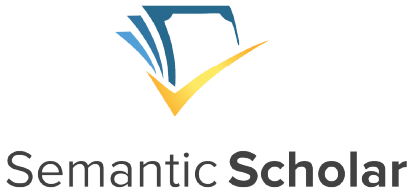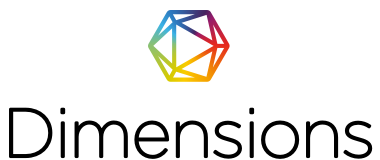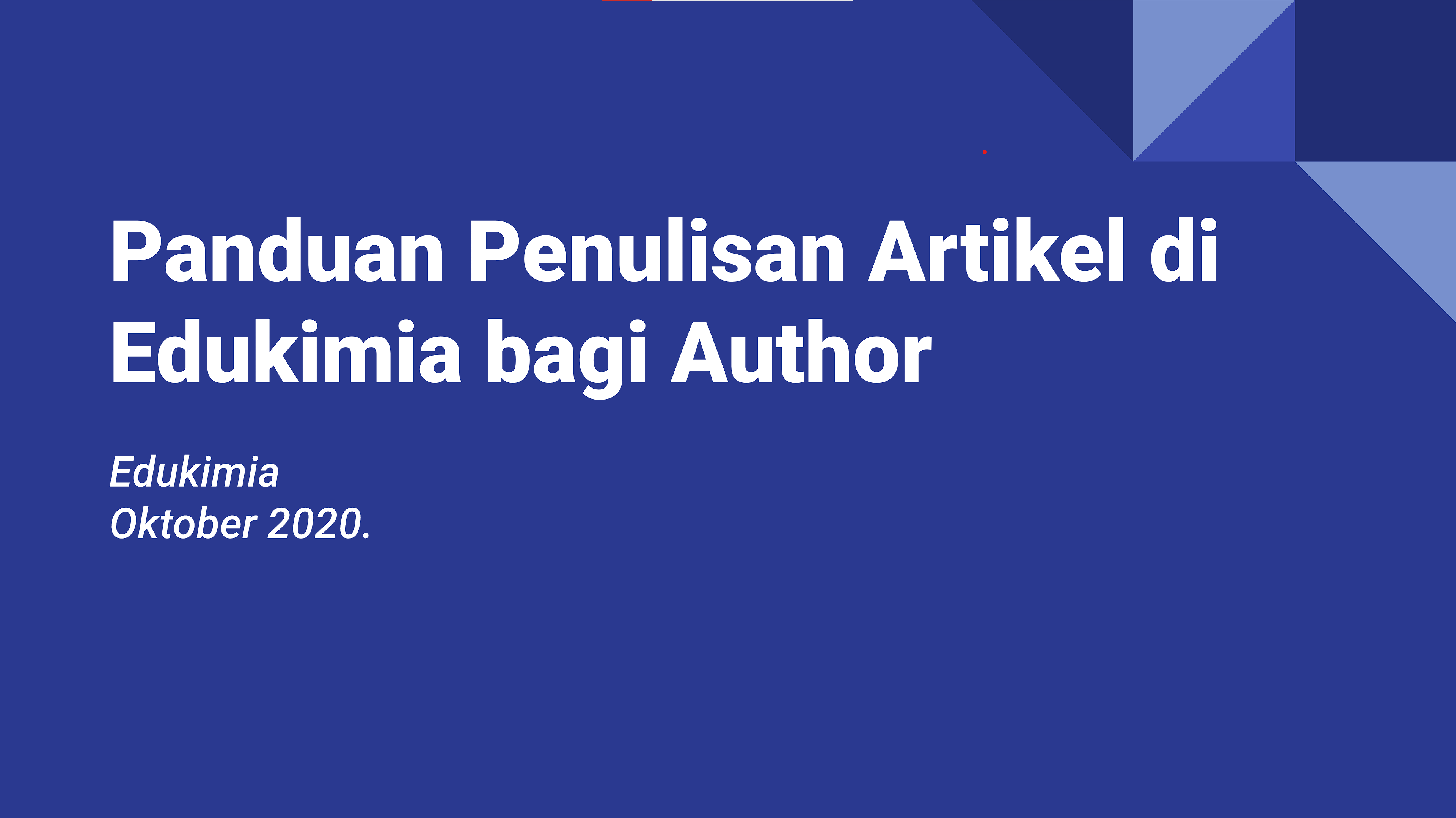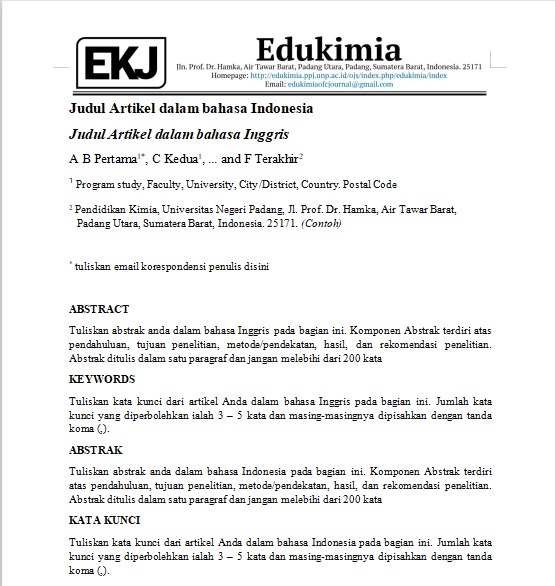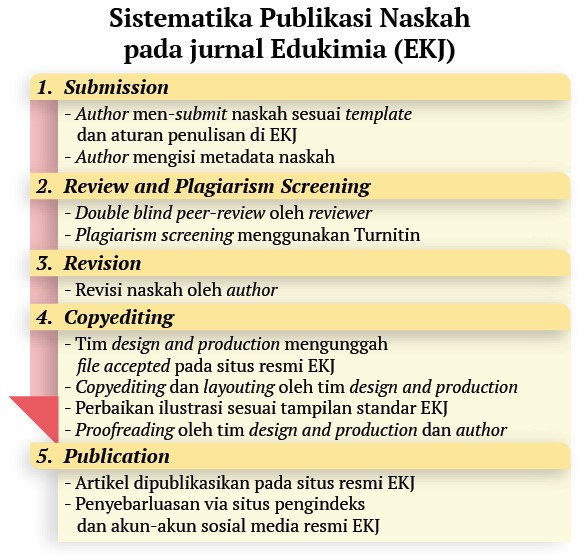Systematic Review on Collaborative Learning in Chemistry
Article Metrics
The abstract has been viewed for 575 times.The full pdf article has been downloaded for 343 times.
Abstract
Keywords
Full Text:
PR_07_432 (Bahasa Indonesia)References
Laal M, Laal M. Collaborative learning : What is it ? Procedia Soc Behav Sci. 2012;31:491–5.
Thobroni M. Belajar dan pembelajaran _ Teori dan Praktik. Yogyakarta: Ar-Ruzz Media; 2015.
Vygotsky LS. Mind and society: The development of higher mental processes. Cambridge, MA: Harvard University Press; 1978. 170 hal.
Hariyanto S dan. Belajar dan Pembelajaran: Teori dan Konsep Dasar. Bandung: Remaja Rosdakarya; 2015.
Schwarz G, Picotti V, Bleiner D, Gundlach-graham A. Incorporating a Student-Centered Approach with Collaborative Learning into Methods in Quantitative Element Analysis. J Chem Educ. 2020;
Ranga JS. Factors In fl uencing Student Learning in Semi-Flipped General Chemistry Courses. J Chem Educ. 2020;
Flener-Lovitt C, Bailey K, Han R. Using Structured Teams to Develop Social Presence in Asynchronous Chemistry Courses. J Chem Educ [Internet]. 2020;97(9):2519–25.
Gemmel PM, Goetz MK, James NM, Jesse KA, Ratliff BJ. Collaborative Learning in Chemistry: Impact of COVID-19. J Chem Educ [Internet]. 2020;97(9):2899–904. Tersedia pada: https://api.elsevier.com/content/abstract/scopus_id/85090989115
Diana PZ. COLLABORATIVE LEARNING DALAM PEMBELAJARAN BAHASA INDONESIA. Yogyakarta; 2020.
Kreijns K, Kirschner PA, Jochems W. Identifying the pitfalls for social interaction in computer-supported collaborative learning environments : a review of the research. Comput Human Behav. 2003;19(3):335–53.
Panitz T. Collaborative versus Cooperative Learning: A Comparison of the Two Concepts Which Will Help Us Understand the Underlying Nature of Interactive Learning. Opinion Papers. 1999;
Roberts TS. Online Collaborative Learning : Theory and Practice. Khosrow-Pour M, editor. United States of America: Information Science Publishing; 2004.
Wesel F van, Boeije HR, Alisic E. Towards a method for synthesizing diverse evidence using hypotheses as common language. Qual Quant. 2014;49(6):2237–49.
Dixon-woods M, Agarwal S, Jones D, Young B, Sutton A. Synthesising qualitative and quantitative evidence : a review of possible methods. J Health Serv Res Policy. 2005;10(1):45–53.
Flemming K. Synthesis of quantitative and qualitative research: an example using Critical Interpretive Synthesis. J Adv Nurs. 2009;66(1):201–17.
CASP. Critical Appraisal Skills Programme (CASP) Systematic Review Checklist. [Internet]. 2018. Tersedia pada: www.casp-uk.net
Elbahri M, Soliman A, Yliniemi K, Abdelaziz R, Homaeigohar S, Zarie ES. Innovative Education and Active Teaching with the Leidenfrost Nanochemistry. J Chem Edu. 2018;
Espinasse A, Jayaraman A, Reisbick SA, Harris CM, Kou Y, Xu H, et al. Model for Student-Led Safety. J Chem Educ. 2020;
Heuvelen KM Van. Emergency remote instruction during the covid-19 pandemic reshapes collaborative learning in general chemistry. J Chem Educ [Internet]. 2020;97(9):2884–8. Tersedia pada: https://api.elsevier.com/content/abstract/scopus_id/85089516160
Naibert N, Duck KD, Phillips MM, Barbera J. Multi-institutional Study of Self-E ffi cacy within Flipped Chemistry Courses. J Chem Educ. 2021;
White KN, Vincent-Layton K, Villarreal B. Equitable and Inclusive Practices Designed to Reduce Equity Gaps in Undergraduate Chemistry Courses. J Chem Educ [Internet]. 2021;98(2):330–9. Tersedia pada: https://api.elsevier.com/content/abstract/scopus_id/85099092931
Crimmins MT, Midkiff B. High Structure Active Learning Pedagogy for the Teaching of Organic Chemistry: Assessing the Impact on Academic Outcomes. J Chem Educ [Internet]. 2017;94(4):429–38.
McCarthy BD, Dempsey JL. Cultivating Advanced Technical Writing Skills through a Graduate-Level Course on Writing Research Proposals. J Chem Educ [Internet]. 2017;94(6):696–702.
Naibert N, Geye E, Phillips MM, Barbera J. Multicourse Comparative Study of the Core Aspects for Flipped Learning: Investigating In-Class Structure and Student Use of Video Resources. J Chem Educ [Internet]. 2020;97(10):3490–505.
Finkenstaedt-quinn SA, Halim AS, Chambers TG, Moon A, Goldman RS, Gere AR, et al. Investigation of the In fl uence of a Writing-to-Learn Assignment on Student Understanding of Polymer Properties. J Chem Educ. 2017;
Bancroft SF, Jalaeian M, John SR. Systematic review of flipped instruction in undergraduate chemistry lectures (2007-2019): Facilitation, independent practice, accountability, and measure type matter [Internet]. Vol. 98, Journal of Chemical Education. 2021. hal. 2143–55. Tersedia pada: https://api.elsevier.com/content/abstract/scopus_id/85108535032
Kou Y, Peng X, Dingwell CE, Reisbick SA, Tonks IA, Sitek AA. Learning Experience Reports Improve Academic Research Safety. J Chem Educ. 2020;
Silva A V., Louro RO. Biomolecular NMR Assignment: Illustration Using the Heme Signals in Horse Cytochrome c. J Chem Educ [Internet]. 2017;94(9):1280–4. Tersedia pada: https://api.elsevier.com/content/abstract/scopus_id/85029221507
Frey RF, Fink A, Cahill MJ, McDaniel MA, Solomon ED. Peer-Led Team Learning in General Chemistry I: Interactions with Identity, Academic Preparation, and a Course-Based Intervention. J Chem Educ [Internet]. 2018;95(12):2103–13.
Summerton L, Clark JH, Hurst GA, Ball PD, Rylott EL, Carslaw N, et al. Industry-Informed Workshops to Develop Graduate Skill Sets in the Circular Economy Using Systems Thinking. J Chem Educ [Internet]. 2019;
Bernardo JMM, Gonzalez AF. Chemical Battleship: Discovering and Learning the Periodic Table Playing a Didactic and Strategic Board Game. J Chem Educ [Internet]. 2021;98(3):907–14. Tersedia pada: https://api.elsevier.com/content/abstract/scopus_id/85100148500
Festa G, Saladino ML, Nardo VM, Armetta F, Renda V, Nasilla G, et al. Identifying the Unknown Content of an Ancient Egyptian Sealed Alabaster Vase from Kha and Merit’s Tomb Using Multiple Techniques and Multicomponent Sample Analysis in an Interdisciplinary Applied Chemistry Course. J Chem Educ. 2020;
Ayral R, Molvinger K. Using Games to Build and Improve 10th Grade Students’ Understanding of the Concept of Chemical Bonding and the Representation of Molecules. J Chem Educ. 2020;
O’Donoghue J. Stories from the Lab: Development and Feedback from an Online Education and Public Engagement Activity with Schools. J Chem Educ [Internet]. 2020;97(9):3271–7. Tersedia pada: https://api.elsevier.com/content/abstract/scopus_id/85090993332
Atieh EL, York DM. Through the Looking CLASS: When Peer Leader Learning Attitudes Are Not What They Seem. J Chem Educ [Internet]. 2020;97(8):2078–90. Tersedia pada: https://api.elsevier.com/content/abstract/scopus_id/85089538940
Ruder SM, Stanford C. Training Undergraduate Teaching Assistants to Facilitate and Assess Process Skills in Large Enrollment Courses. J Chem Educ [Internet]. 2020;97(10):3521–9. Tersedia pada: https://api.elsevier.com/content/abstract/scopus_id/85091039312
Roschelle J, Teasley SD. The Construction of Shared Knowledge in Collaborative Problem Solving. Comput Support Collab Learn. 1995;69–97.
Mathabathe KC, Potgieter M. Manifestations of metacognitive activity during the collaborative planning of chemistry practical investigations. Int J Sci Educ. 2017;39(11):1465–84.
Laal M, Laal M. Collaborative learning : What is it ? Procedia Soc Behav Sci. 2012;31(December 2012):1–6.
Leeuwen A van, Janssen J. A systematic review of teacher guidance during collaborative learning in primary and secondary education [Internet]. Vol. 27, Educational Research Review. Elsevier BV; 2019. hal. 71–89. Tersedia pada: http://dx.doi.org/10.1016/j.edurev.2019.02.001
Webb NM, Mastergeorge AM. The Development of Students ’ Helping Behavior and Learning in Peer-Directed Small Groups. Cogn Instr. 2010;21(4):361–428.
Pun JKH, Ka K, Cheung C. Meaning making in collaborative practical work : a case study of multimodal challenges in a Year 10 chemistry classroom. Res Sci Technol Educ [Internet]. 2021;39(1):1–18. Tersedia pada: https://doi.org/10.1080/02635143.2021.1895101
Nichols K, Gillies R, Hedberg J. Argumentation-Based Collaborative Inquiry in Science Through Representational Work : Impact on Primary Students ’ Representational Fluency. Res Sci Educ. 2015;46(3):343–64.
Bellova R, Melicherc D, Tomcik P. Approximate Relations in pH Calculations for Aqueous Solutions of Extremely Weak Acids: A Topic for Problem-Based Learning. J Chem Educ. 2018;
Tomat E. Chemistry Discovery: A Service-Learning Outreach Course Produces a Workshop Series for Middle-School Students. J Chem Educ [Internet]. 2020;97(11):4019–25. Tersedia pada: https://api.elsevier.com/content/abstract/scopus_id/85092392099
Özkanbaş M, Kirik OT. Implementing collaborative inquiry in a middle school science course. Chem Educ Res Pract [Internet]. 2020;21(4):1199–217. Tersedia pada: https://api.elsevier.com/content/abstract/scopus_id/85094863645
Williams P. Assessing collaborative learning : big data , analytics and university futures. Assess Eval High Educ. 2016;42(6):978–89.
Mullins D, Rummel N, Spada H. Are two heads always better than one ? Differential effects of collaboration on students ’ computer-supported learning in mathematics. Comput Support Collab Learn. 2011;6(3):421–43.
Hibbard L. Case Studies for General Chemistry: Teaching with a Newsworthy Story. J Chem Educ [Internet]. 2019;96(11):2528–31.
Ginzburg AL, Check CE, Hovekamp DP, Sillin AN, Brett J, Eshelman H, et al. Experiential Learning to Promote Systems Thinking in Chemistry: Evaluating and Designing Sustainable Products in a Polymer Immersion Lab. J Chem Educ [Internet]. 2019;96(12):2863–71.
Stockard J, Greene J, Richmond G, Lewis P. Is the Gender Climate in Chemistry Still Chilly? Changes in the Last Decade and the Long-Term Impact of COACh-Sponsored Workshops. J Chem Educ [Internet]. 2018;95(9):1492–9.
Kaendler C, Wiedmann M, Rummel N, Spada H. Teacher Competencies for the Implementation of Collaborative Learning in the Classroom : a Framework and Research Review. Educ Res Rev. 2015;27(3):505–36.
Ritchie TS, Cardenas MTP, Ganapati S. Establishment and Implementation of a Peer-Supported Professional-Development Initiative by Doctoral Students, for Doctoral Students. J Chem Educ [Internet]. 2018;95(11):1947–53.
Qureshi MA, Khaskheli A, Qureshi JA, Raza A, Yousufi SQ. Factors affecting students ’ learning performance through collaborative learning and engagement. Interact Learn Environ [Internet]. 2021;0(0):1–21. Tersedia pada: https://doi.org/10.1080/10494820.2021.1884886
Mousavi MPSM, Sohrabpour Z, Anderson EL, Stemig-Vindedahl A, Golden D, Christenson G, et al. Stress and Mental Health in Graduate School: How Student Empowerment Creates Lasting Change. J Chem Educ [Internet]. 2018;95(11):1939–46.
Knox KJ, Gillis AL, Dake GR. Research and Practice project work in upper-year undergraduate chemistry. Chem Educ Res Pract. 2019;
Hei MSA De, Sjoer E, Admiraal W, Strijbos J, Hei MSA De, Sjoer E, et al. Teacher educators ’ design and implementation of group learning activities. Educ Stud. 2016;42(2):394–409.
Heeg J, Hundertmark S, Schanze S. THe interlplay between indivual Reflection and Collaborative learning – seven essential features develop students ’ individual conceptions. Chem Educ Res Pract. 2020;
Flaherty A, O’Dwyer A, Mannix-McNamara P, Leahy J. Aligning Perceptions of Laboratory Demonstrators’ Responsibilities to Inform the Design of a Laboratory Teacher Development Program. J Chem Educ [Internet]. 2017;94(8):1007–18.
Donnelly DF, Hume A. Using collaborative technology to enhance pre-service teachers’ pedagogical content knowledge in Science. Res Sci Technol Educ [Internet]. 2015;33(1):61–87.
Elbahri M. Comment on “synthesizing Gold Nanoparticles Using Honey in Basic Solution under Leidenfrost Conditions to Aid Students in Reliably Reproducing Observable Color Changes.” J Chem Educ [Internet]. 2020;97(3):878–9. Tersedia pada: https://api.elsevier.com/content/abstract/scopus_id/85081923853
Leopold H. Implementing reflective group work activities in a large chemistry lab to support collaborative learning. Educ Sci [Internet]. 2020;10(1).
Mutambuki JM, Fynewever H, Douglass K, Cobern WW, Obare SO. Integrating Authentic Research Experiences into the Quantitative Analysis Chemistry Laboratory Course: STEM Majors’ Self-Reported Perceptions and Experiences. J Chem Educ [Internet]. 2019;96(8):1591–9.
McDowell TR, Schmittzehe ET, Duerden AJ, Cernusca D, Collier H, Woelk K. A Student-Choice Model to Address Diverse Needs and Promote Active Learning. J Sci Educ Technol [Internet]. 2019;28(4):321–8. Tersedia pada: https://api.elsevier.com/content/abstract/scopus_id/85060681951
Talanquer V, Pollard J. Reforming a Large Foundational Course: Successes and Challenges. J Chem Educ [Internet]. 2017;94(12):1844–51.
Goethe E V, Colina CM. Taking Advantage of Diversity within the Classroom. J Chem Educ. 2017;
Mitra S, Wagner E. Introducing undergraduates to primary research literature. J Chem Educ [Internet]. 2021;98(7):2262–71. Tersedia pada: https://api.elsevier.com/content/abstract/scopus_id/85110231866
Zeng H, Zhou S-N, Hong G-R, Li Q, Xu S-Q. Evaluation of Interactive Game-Based Learning in Physics Domain. J Balt Sci Educ. 2020;19(3):484–98.
Huelsmann RD, Vailati AF, Laia LR de, Tessaro PS, Xavier FR. Tap It Fast! Playing a Molecular Symmetry Game for Practice and Formative Assessment of Students’ Understanding of Symmetry Concepts. J Chem Educ [Internet]. 2018;95(7):1151–5.
Brydges S, Dembinski HE. Catalyze! Lowering the Activation Barriers to Undergraduate Students ’ Success in Chemistry: A Board Game for Teaching Assistants. J Chem Educ. 2018;
Miller JL, Wentzel MT, Clark JH, Hurst GA. Green Machine: A Card Game Introducing Students to Systems Thinking in Green Chemistry by Strategizing the Creation of a Recycling Plant. J Chem Educ [Internet]. 2019;96(12):3006–13.
Thangjai N. Developing Inquiry Learning Characteristics of Grade 7 Students Using Integrated 5E ’ s of Inquiry-Based Learning and Game-Based Learning. J Educ Issues. 2022;8(1):137–50.
Czauderna A, Guardiola E. Remote Collaboration in Higher Game Development Education . Online Practices and Learning Processes of Students between Professional Routines and Psychosocial Challenges. High Educ Stud. 2021;11(2):1–19.
Dietrich N, Jimenez M, Souto M, Harrison AW, Coudret C, Olmos E. Using Pop-Culture to Engage Students in the Classroom. J Chem Educ [Internet]. 2021;98(3):896–906. Tersedia pada: https://api.elsevier.com/content/abstract/scopus_id/85100729679
Vergne MJ. Escape the Lab: An Interactive Escape-Room Game as a Laboratory Experiment. J Chem Educ [Internet]. 2019;96(5):985–91. Tersedia pada: https://api.elsevier.com/content/abstract/scopus_id/85065065299
Avargil S, Shwartz G, Zemel Y. Educational Escape Room: Break Dalton’s Code and Escape! J Chem Educ [Internet]. 2021;98(7):2313–22. Tersedia pada: https://api.elsevier.com/content/abstract/scopus_id/85108581125
Muelleman AW, Glaser RE. Learning To Read Spectra: Teaching Decomposition with Excel in a Scientific Writing Course. J Chem Educ. 2018;
Gandhi HA, Jakymiw S, Barrett R, Mahaseth H, White AD. Real-Time Interactive Simulation and Visualization of Organic Molecules. J Chem Educ [Internet]. 2020; Tersedia pada: https://api.elsevier.com/content/abstract/scopus_id/85092362516
Limpanuparb T, Datta S, Tawornparcha P, Chinsukserm K. ACAD-Feedback: Online Framework for Assignment, Collection, Analysis, and Distribution of Self, Peer, Instructor, and Group Feedback. J Chem Educ [Internet]. 2021;98(9):3038–44. Tersedia pada: https://api.elsevier.com/content/abstract/scopus_id/85114110053
Skagen D, McCollum B, Morsch L, Shokoples B. Developing communication confidence and professional identity in chemistry through international online collaborative learning. Chem Educ Res Pract [Internet]. 2018;19(2):567–82. Tersedia pada: https://api.elsevier.com/content/abstract/scopus_id/85048695324
Houseknecht JB, Bates LK. Transition to Remote Instruction Using Hybrid Just-in-Time Teaching, Collaborative Learning, and Speci fi cations Grading for Organic Chemistry 2. J Chem Educ. 2020;
Dietrich N, Kentheswaran K, Ahmadi A, Teychene J, Bessiere Y, Alfenore S, et al. Attempts, successes, and failures of distance learning in the time of covid-19. J Chem Educ [Internet]. 2020;97(9):2448–57.
Young SC. Incorporating Interlab Collaborations into the Organic Chemistry Teaching Laboratories. J Chem Educ [Internet]. 2021;98(9):2848–60. Tersedia pada: https://pubs.acs.org/doi/full/10.1021/acs.jchemed.0c01350
Flaherty A, O’Dwyer, Mannix-McNamara P, Leahy JJ. Evaluating the Impact of the “Teaching as a Chemistry Laboratory Graduate Teaching Assistant” Program on Cognitive and Psychomotor Verbal Interactions in the Laboratory [Internet]. Vol. 94, Journal of Chemical Education. 2017. hal. 1831–43.
Kovarik ML, Robinson JK. Collaborative Learning Exercises for Teaching Protein Mass Spectrometry. J Chem Educ [Internet]. 2019;96(5):905–11. Tersedia pada: https://api.elsevier.com/content/abstract/scopus_id/85065713901
Zhang S, Xu R, Zhu H, Kern REB, Spillman MG, Chen ES, et al. Reaction of Diphenyldiazomethane with Benzoic Acids in Batch and Continuous Flow. J Chem Educ [Internet]. 2021;98(2):469–77. Tersedia pada: https://api.elsevier.com/content/abstract/scopus_id/85100104245
Williams NA. Using an Inclusive Curriculum Framework to Address an Awarding Gap in a First-Year Chemistry Module. J Chem Educ [Internet]. 2021; Tersedia pada: https://api.elsevier.com/content/abstract/scopus_id/85111527136
Rubush DM. A learning community involving collaborative course-based research experiences for foundational chemistry laboratories. Educ Sci [Internet]. 2020;10(4). Tersedia pada: https://api.elsevier.com/content/abstract/scopus_id/85083844581
Refbacks
- There are currently no refbacks.

.jpg)



